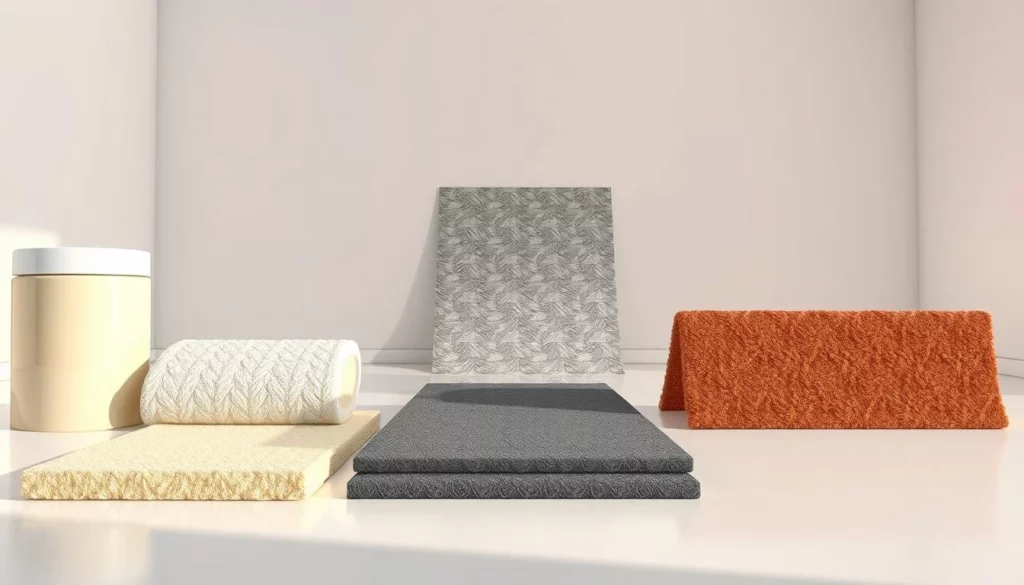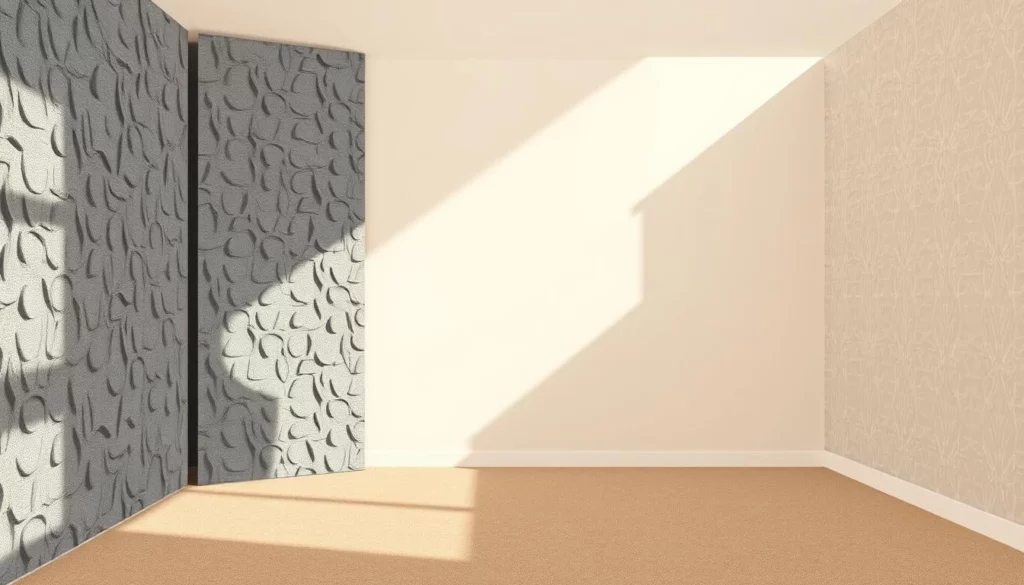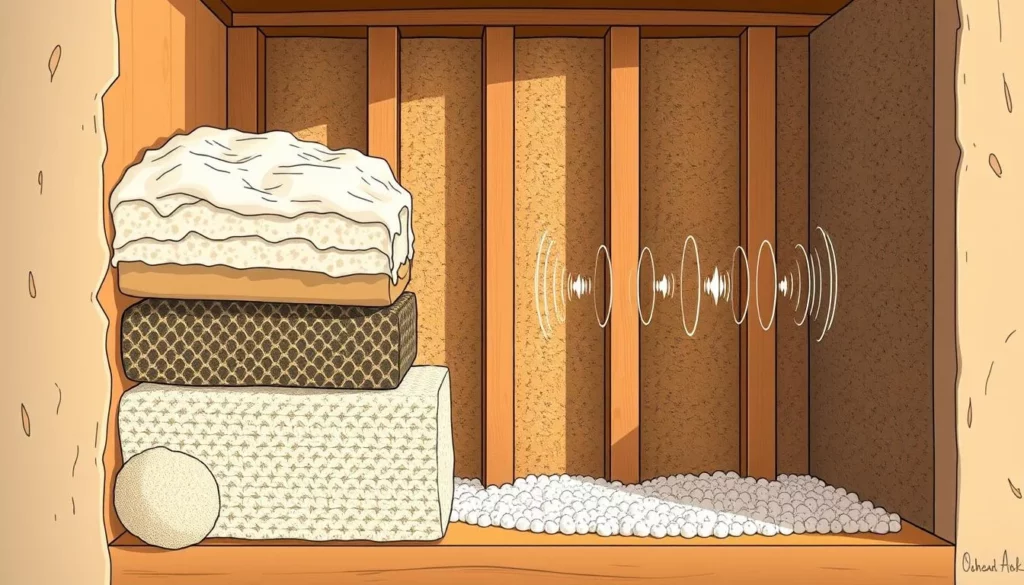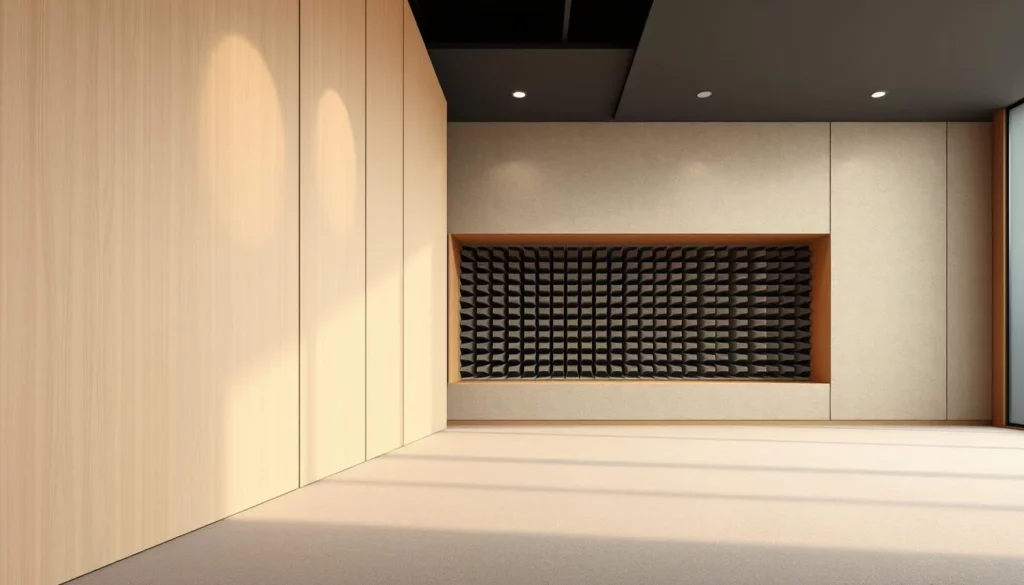Ever wish your home could be both stylish and peaceful? Unwanted echoes or loud neighbors don’t have to ruin your sanctuary. Modern solutions now blend design with practicality to tackle noise where it starts: your walls and ceilings.
Sound travels easily through thin surfaces, bouncing between rooms and amplifying distractions. Traditional fixes like foam panels work but lack visual appeal. Today’s options, like acoustic wallcoverings, absorb vibrations while adding texture or color to your space. Brands like Arte and Elitis even offer custom patterns with verified noise-dampening performance.
Why does this matter? These materials don’t just block external noise—they improve room acoustics. Conversations stay clear, and private moments stay confidential. Better yet, they’re simpler to install than retrofitting walls with bulky insulation.
In this guide, you’ll learn how to choose the right products for walls or ceilings. We’ll break down installation tips and compare how different thicknesses affect results. Whether you’re redesigning a home office or calming a busy living area, you’ll find strategies that balance form and function.
The Fundamentals of Soundproofing and Acoustic Absorption
Noise sneaks through walls like uninvited guests—but science offers ways to keep it out. Understanding how vibrations move through your space helps you choose materials that absorb or block them effectively.
How Sound Behaves in Your Space
Sound waves bounce off hard surfaces, creating echoes. Soft, dense materials interrupt this movement by converting energy into heat. For example, foam panels with a Noise Reduction Coefficient (NRC) of 0.85 absorb 85% of incoming noise.
Why Thickness and Density Matter
Thicker materials trap more vibrations. Studios use 2-inch foam for maximum absorption, but 1-inch options work for homes. Heavy fabrics or specialized wallcoverings add density without bulky installations.
Key insight: A 0.5-inch panel might have an NRC of 0.60, while doubling its thickness boosts performance by 30%. Doors with solid cores reduce noise transfer better than hollow ones, proving every building component plays a role.
Soundproof paint and wallpaper: Innovative Solutions for Noise Reduction
Gone are the days when noise reduction meant sacrificing your home’s aesthetic appeal. Advanced materials now tackle unwanted sound while blending seamlessly with your existing decor. Unlike bulky foam panels or disruptive drywall installations, these solutions work with your design vision—not against it.
Thin Yet Powerful Performance
High-end options like BuzziSkin’s acoustic panels are just 0.3 inches thick but reduce mid-frequency noise by up to 70%. Traditional methods—like adding mass-loaded vinyl or extra drywall layers—require invasive construction. Sound-dampening wallcoverings install like regular wallpaper, often in under two hours per room.
Design Flexibility You’ll Love
Where foam panels clash with curtains or window treatments, textured wallcoverings from brands like Easewall enhance rooms visually. Their woven fabrics and metallic finishes pair effortlessly with doors, trim, or furniture. Bonus: Many options improve thermal insulation, cutting energy costs by 12-15% according to recent tests.
Choosing between function and style is no longer necessary. These innovations prove you can have both—without compromising on either front.
Choosing the Right Materials and Techniques for Your Space
Selecting effective noise-reduction solutions requires balancing performance with practicality. Each material offers unique qualities that suit different rooms and lifestyles. Let’s break down your options to simplify decision-making.

Material Comparison: What Works Best?
| Material | Installation Time | Sound Absorption | Energy Impact |
|---|---|---|---|
| Acoustic Wallcoverings | 1-2 hours | Moderate (NRC 0.6) | Improves insulation by 12% |
| Foam Panels | 3-4 hours | High (NRC 0.8) | Minimal thermal benefit |
| Layered Fiber Panels | 4+ hours | Exceptional (NRC 1.0) | Reduces heating costs by 18% |
Smart Installation Strategies
Air gaps around windows or doors undermine even the best materials. Use silicone caulk to seal cracks thinner than ¼ inch—it remains flexible to handle temperature shifts. For larger spaces, apply adhesive-backed foam tape before installing panels.
Layering materials boosts results. Combine dense wallcoverings with thin foam layers to block mid-frequency noises like voices. Pro tip: Install door sweeps with rubber seals to prevent sound leaks at floor gaps.
Match your choices to room needs. Bedrooms benefit from maximum absorption qualities, while home offices need balanced acoustics. Always test small sections first—some adhesives may damage delicate surfaces over time.
Integrating Comprehensive Noise Reduction Strategies in Your Home
Transforming your home into a peaceful retreat requires more than just a single solution. Combining multiple techniques creates a layered defense against unwanted noise. This approach tackles vibrations at every entry point while enhancing your space’s functionality.
Enhancing Walls, Ceilings, and Doors for Better Soundproofing
Start by addressing weak spots. Install mass-loaded vinyl between wall layers to block low-frequency rumbles. For ceilings, resilient channels decouple drywall from joists, reducing impact noise from upstairs. Solid-core doors with automatic sweeps prevent 90% of sound leaks compared to hollow models.
Complementary Solutions: Sealants, Curtains, and Underlayment
Small gaps around windows and vents account for 30% of noise intrusion. Acoustic sealant fills cracks permanently without cracking. Pair heavy-duty curtains with thermal lining to dampen street noise. For floors, cork underlayment reduces footfall sounds by 50% while adding natural warmth.
| Solution | Noise Reduction | Cost | Installation Time |
|---|---|---|---|
| Acoustic Sealant | Blocks 25% airborne noise | $8/tube | 20 mins per window |
| Mass-Loaded Vinyl | Cuts 70% impact noise | $1.50/sq ft | 2-3 hours per wall |
| Soundproof Curtains | Reduces 40% exterior noise | $60-$120/panel | 5 mins |
Customizing Your Approach for Different Rooms
Home theaters need maximum sound absorption—use fabric-wrapped panels on walls and thick carpets. Bedrooms benefit from layered drywall with green glue compound. In home offices, position acoustical panels at reflection points to clarify speech during calls.
Mix traditional and modern methods strategically. A living room might combine decorative wall panels with bass traps in corners. Kitchens can use cork backsplashes paired with silicone-sealed cabinets. Always test materials in small areas first to ensure compatibility with existing surfaces.
Conclusion
Ready to reclaim your space from unwanted noise? Modern design-forward materials prove you don’t need bulky panels or disruptive renovations. By blending style with science, today’s options tackle vibrations at their source while enhancing your room’s visual appeal.
Key takeaway: Effective noise control starts with addressing every transmission path. Walls, floors, and ceilings each play a role in how sound travels. High-performance coverings absorb mid-frequency chatter, while sealants and underlayments block impact noises like footsteps. For detailed guidance, explore our step-by-step installation guide to maximize results.
Make sure to compare material thickness, density, and installation methods. Thicker panels or layered solutions help reduce echoes in larger rooms, while thinner options suit compact spaces. Always test adhesives on small areas first to protect delicate surfaces.
Your choices directly impact room functionality. Whether upgrading a home office or creating a serene bedroom, the right acoustic wall treatments balance aesthetics with performance. With strategic planning, these solutions transform chaotic environments into peaceful retreats—no compromise required.




